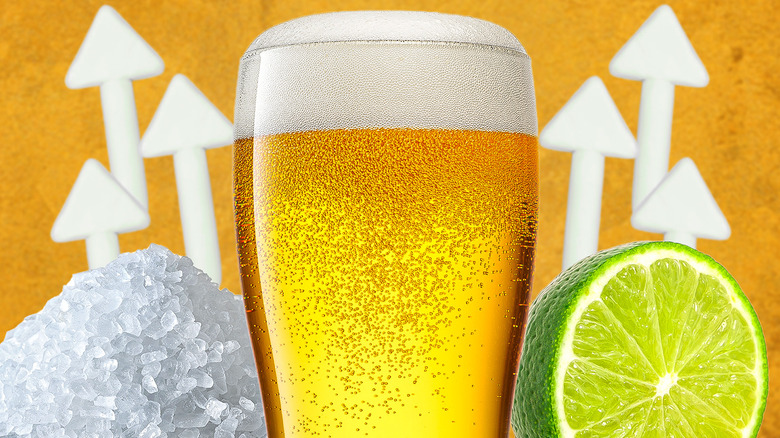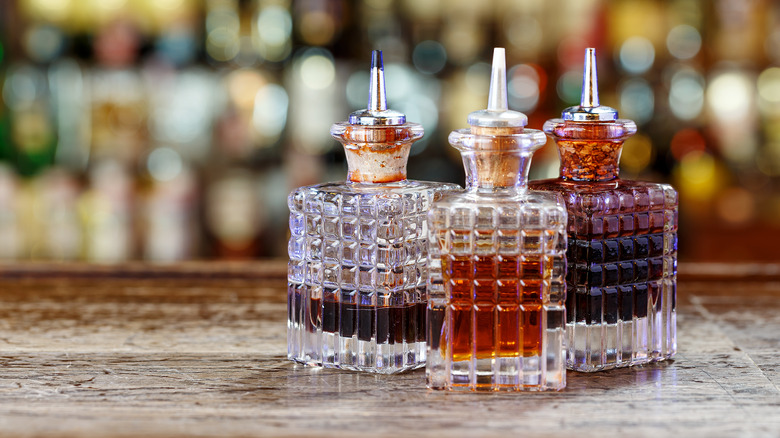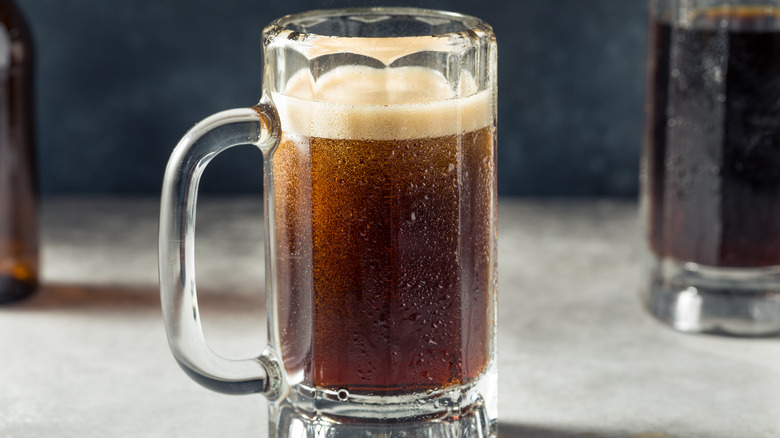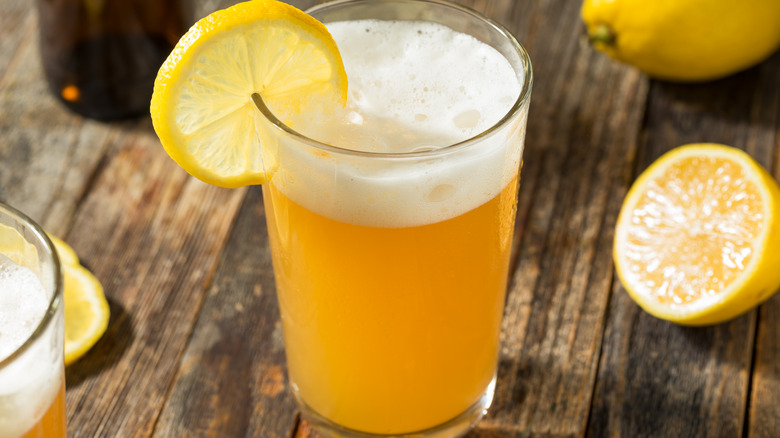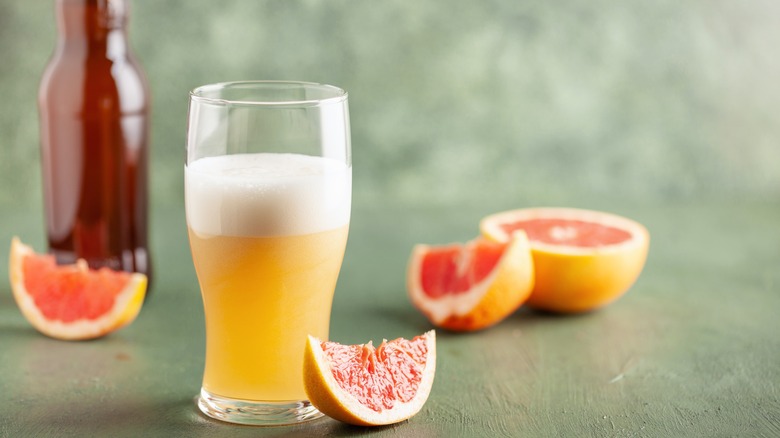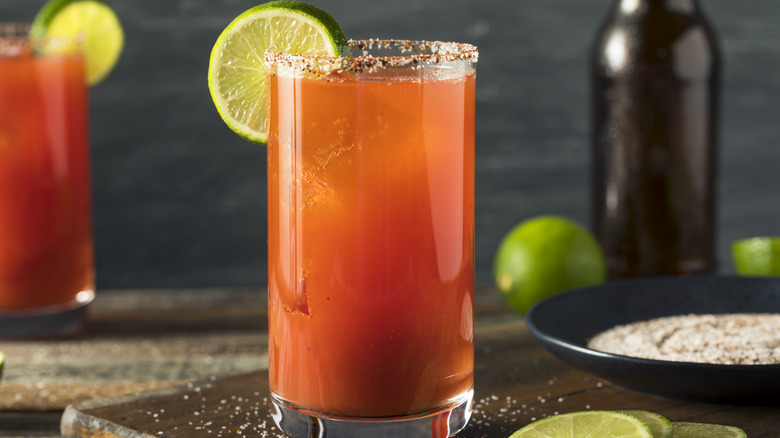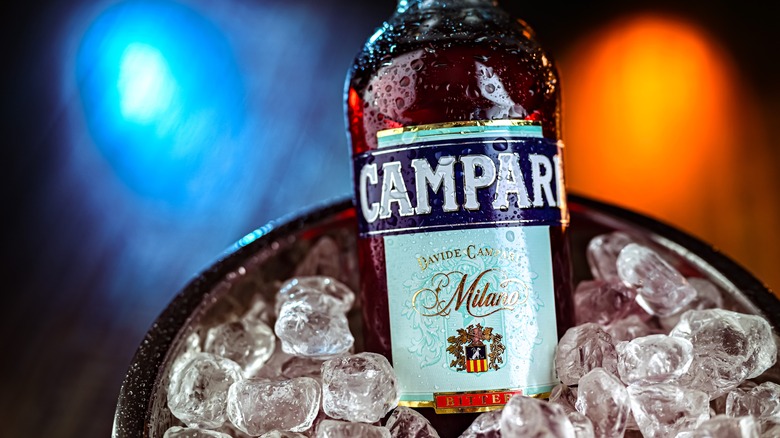6 Simple Ways To Make Cheap Beer Taste So Much Better
People have a love-hate relationship with cheap beer. The main upside is the price. Combine that with the light flavor and low alcohol content and you've got yourself the perfect partner for your weekend bender. But the downsides are real. The light flavor of a cheap lager is nice on a hot, sunny day but it doesn't exactly taste good, especially when compared to the unique flavor profiles craft brewers have been able to achieve. Let's be honest, if all beer was the same price, cheap beers would dissolve into the void in the blink of an eye.
The "cheap beer is gross" mantra is a cliche at this point, but that doesn't change the fact that the majority of us would pick a different option if money were no object. It just so happens that there's a middle ground where everyone wins and we're gonna get there with a little help from the cocktail world. People have been mixing spirits and flavorings together for a while now, so why not do the same for beer?
Because beer cocktails aren't that widespread, most people are suspicious of adding things into their beer but we actually do it all the time. Mexican lagers are served with a lime wedge more often than not and we don't bat an eye at a salt rim. In pursuit of expanding this particular Overton window, here are six ways to make cheap beer taste better.
Cocktail bitters provide complex flavors
Adding cocktail bitters to beer may seem sacrilegious. After all, brewers work hard to get the flavor profile just right. But cheap beer is not an example of masterful artistry on par with a Gustav Klimt. If anything, cheap beer is a blank tapestry ready to be covered with something more interesting and in this case your oil paint goes by the name of bitters.
There is a whole world of cocktail bitters and each is doing something unique, but Angostura is by far the most well-known and it's a good fit here. Angostura bitters have a difficult flavor profile to categorize but they have a semi-bitter pungency that's reminiscent of a cola with hints of clove and cinnamon tucked inside. This is a versatile additive that you can experiment with, but we'd recommend starting with something simple like a Pabst Blue Ribbon or a Bud Light and going from there.
The second most popular cocktail bitters on the market is Peychaud's which has a more fruit-forward flavor profile that calls to mind grapefruit and cherries with a touch of mint. Bitters are a fascinating bar category because they are essentially hyper-condensed flavors which is why you only need to add a few drops to get the benefit but that force of flavor doesn't keep it from being overpowering so, again, quite versatile. Shake a few drops of Peychaud's into a Michelob Ultra and see what happens.
Soda adds a bubbly sweetness to beer
If you're looking for a sweet twist on cheap beer, add some soda to the mix. You'll probably want to lean towards lighter sodas such as Sprite so the flavors don't clash. Speaking of which, the best beers for the job are ones that are weakest in flavor. Soda already has its own personality, so even picking something like a Budweiser could be too flavorful to mix well. Mild beers like Natural Light and Busch Light would be good options for this reason. As for proportions, this may come down to personal preference but adding two parts beer and one part soda is a good place to start. You can adjust from there by adding more of one or the other ingredient.
If we're being honest, citrus sodas are the most popular option to mix with beer followed closely by ginger beer. You can get more adventurous with this, though. There are lots of great sodas from around the world and it would be fun to pair those up with like-minded brews. Orangina has a strong orange citrus flavor that would go well in a Stella Artois to make something like a cheap Mimosa alternative. There are also plenty of Jarritos flavors that are fruit-forward that would be fun in a Dos Equis or a Corona. In Germany, some people will mix their beer with Coca Cola which strikes us as bold but well worth a try.
Adding lemonade to beer is what we in the business call a shandy
If you've ever had a shandy before, you know exactly how delicious beer and lemonade are together. The lack of carbonation in the lemonade does soften the drink's effervescence somewhat but it's not that big of a deal. Worst case scenario you can add some more beer to up the bubbly. Full disclosure, a shandy is made differently depending on what part of the world you happen to be drinking in. Some places use lemon-lime soda like Sprite while others use ginger beer. But in the United States, lemonade is the typical ingredient for shandies.
Add equal parts beer and lemonade to your glass and you're off to the races. This is a great drink on a hot sunny day — hence the alternate title of summer shandy. There's really no limit on what beer you can use for this so don't shy away from tossing in whatever is at hand. That said, we would recommend a Michelob Ultra, a Miller High Life, or a Budweiser for this mixture. Even though a shandy has become a tradition all its own, it wasn't that long ago that the drink was first created. It may not be as popular as it once was, but even old recipes make fresh bread, if you catch our meaning.
Mixing fruit juice with beer is a delicious classic
If the huge surge in popularity of fruit beers is anything to go by, juice and beer are a match made in heaven. The combination of beer and juice is known as a radler. Radlers and shandies are notoriously difficult to differentiate because most people use the names interchangeably but they are two different things.
Because radlers are designated as anything that mixes beer with juice, that leaves us with a whole lot of options. You can take a ride with the Beastie Boys and sip a Brass Monkey which mixes beer and orange juice, you can join the Germans and mix beer with banana juice, or you can go old school and use grapefruit juice.
With so many variations to choose from, we're going to stay pretty general on how to prepare a radler. Going 50/50 on juice and beer is a safe place to start but depending on the ingredients and your preference you may want to adjust. Choosing your beer is also going to vary depending on what juice you pick but Miller High Life and Coors Banquet would both pair well with multiple types of juice. If you go with something more savory like tomato juice, a Mexican lager like Corona may be better.
Hot sauce gives beer a bold kick
You may have noticed that several of these beer hacks get their inspiration from beer cocktails. Hot sauce and beer may seem like odd bedfellows but we're essentially making a stripped down Michelada here. In a classic Michelada, you're taking a Mexican lager and mixing it with Tabasco, Worcestershire sauce, and either tomato juice, Clamato juice, or lime juice. The idea is to create a bubbly Bloody Mary spinoff but you don't need to fill an entire grocery bag to make this version.
We're not going to buck tradition too much, so Mexican lager is still the brew of choice. Pacifico is always a favorite but Modelo, Corona, or Dos Equis will do. As for the hot sauce, while the spice is nice we want to maximize on flavor. Tabasco is an okay choice when you've got other flavorful ingredients but Valentina is a better option with Cholula being a close second.
The easiest way to prepare this is to simply crack open the bottle and toss a couple dashes of hot sauce inside but that's not your only option. If you have a pint glass handy, you can also coat the rim with hot sauce instead of adding it directly. And from here, you can get as complicated as you like, all the way up to a super-garnished Michelada.
Beer and Campari are deliciously botanical together
For our final beer hack we're heading over to Italy to steal one of their most popular liqueurs — Campari. Until now, we've focused on mixers that are non-alcoholic (cocktail bitters technically have alcohol but we only use a few drops). Campari will up the ABV, so keep that in mind.
This one's very simple to throw together, just take a swig from your bottle of beer and fill it back up with Campari. Miller High Life is an excellent choice but a Coors Light would work well, too. Campari is an amaro which is a family of Italian liqueurs known for their bitter botanical profile. Compared to other amaros, Campari is fruit-forward with strong hints of orange and grapefruit. It's often compared and confused with Aperol, though Aperol is the sweeter of the two. If the Campari is too bitter for you, you can easily substitute Aperol in for this upgrade. If it's still too much, add a squeeze of lemon juice to take the edge off.
The cheap beer hacks don't stop here but this is a good place to start. Plenty of people will skip the beer and a shot mentality and simply add spirits directly into their brew, sort of like this Campari and beer idea only at a higher proof. Don't be afraid to experiment.
